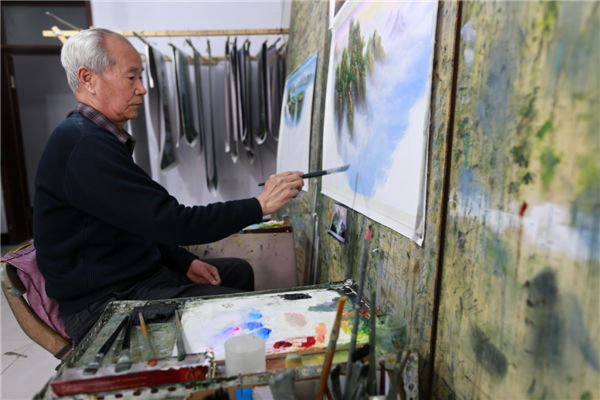 |
|
Photo by Feng Yongbin /China Daily |
Lin showed great interest in art when he was child, but his parents could not afford to send him to proper art classes. However, there was a furniture factory on his way home from school, and he saw workers decorating the furniture with pictures.
He volunteered to become an apprentice, but was turned down.
"They didn't allow me to enter, so I stood outside and looked through the window and imitated what I saw at home. My mother said I was crazy because I went to watch at the window everyday, no matter if it were winter or summer, sunshine or rain," Lin says.
"One very cold day they allowed me inside. My hands were frozen after spending so long standing in the open air," he says.
Under their instruction, Lin made major progress and become one of the best painters in the factory. But his dream was not limited to painting furniture. Lin became the first student of Song in the 1970s before entering the Sichuan Fine Arts Institute to study painting,
Thanks to the tireless promotional efforts of Lin and other well-known artists such as Xu Jiachi, Wang Ying, Song Junjie and Yan Guocheng, knife painting has become an important cultural industry in Dunhua city.
Data from Dunhua Culture Bureau show that more than 2,000 professions work on knife painting. There are about 20 large knife painting studios in Dunhua, that are helping the city cultivate more professionals.
"Thinking of his own experience, Lin figured that there must be more people like him who love painting but whose family cannot afford the education," says Su Yizhong, general secretary of the Dunhua Knife Painting Association.
"To provide more chances for young people and people in need to study knife painting, Lin has taken on many students in different cities and taught them free of charge. He also has helped disabled people and the unemployed, as long as they love painting and would like to learn."
Lin said he feels the future of knife painting is strong.
"I often read the news that some older craftsmen or folk artists are worried that their traditional skills will be lost to the world. Knife painting is also a form of folk art, and we are lucky that the art form still has huge market demand and have people willing to learn. As long as people want to learn, I will teach, because promoting the skill is my top responsibility," Lin says.
|
|
|
|
|
|
